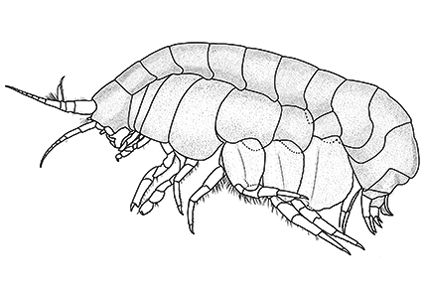Abstract
A new genus of the family Uristidae Hurley, 1963 is proposed, Liuiuristis gen. nov., with new species L. thermalis sp. nov. as the type species based on specimens collected by the expedition to hydrothermal vents on the Okinawa Trough. The new genus is characterized by the shape of accessory flagellum liking cap, the outer plate of the maxilla 1 having 11 setal-teeth, the gnathopod 1 parachelate in female and subchelate in male, the rami of the uropod 3 without plumose setae and the telson not cleft. K2P divergences of the mitochondrial COI gene in taxa attributed to Liuiuristis gen. nov. is presented.
References
- Barnard, J.L. & Ingram, C.L. (1990). Lysianassoid Amphipoda (Crustacea) from deep-sea thermal vents. Smithsonian Contributions to Zoology, 499, 1–80. https://doi.org/10.5479/si.00810282.499
- Barnard, J.L. & Karaman, G.S. (1987). Revisions in Classification of Gammaridean Amphipoda (Crustacea). Part 3. Proceedings of the Biological Society of Washington, 100 (4), 856–875. [http://biostor.org/reference/74783]
- Barnard, J.L. & Karaman, G.S. (1991) The families and genera of marine gammaridean Amphipoda (except marine gammaroids). Part 2. Records of the Australian Museum, Supplement, 13 (2), 419–866. https://doi.org/10.3853/j.0812-7387.13.1991.367
- Bellan-Santini, D. (1997) Amphipods of the cold seep community on the South Barbados Accretionary Prism. Crustaceana, 70, 1–30. https://doi.org/10.1163/156854097x00311
- Birstein, J.A. & Vinogradov, M.E. (1960) [Pelagic gammarids from the tropical Pacific Ocean]. Akademiya Nauk SSSR, Trudy Instituta Okeanologii, 34, 165–241. [in Russian]
- Diffenthal, M. & Horton, T. (2007) Stephonyx arabiensis (Crustacea: Amphipoda: Lysianassoidea: Uristidae), a new deep-water scavenger species from the Indian Ocean, with a key to the genus Stephonyx. Zootaxa, 1665 (1), 31–41. https://doi.org/10.11646/zootaxa.1665.1.3
- Griffiths, C.L. (1977) Deep-sea amphipods from west of Cape Point, South Africa. Annals of the South African Museum, 73, 93–104.
- Havermans, C., Nagy, Z.T., Sonet, G., De Broyer, C. & Martin, P. (2010) Incongruence between molecular phylogeny and morphological classification in amphipod crustaceans: A case study of Antarctic Lysianassoids. Molecular Phylogenetics and Evolution, 55, 202–209. https://doi.org/10.1016/j.ympev.2009.10.025
- Kilgallen, N.M. (2009) New species of lysianassoid Amphipoda (Crustacea) associated with seamounts, marine canyons and cold seeps of New Zealand. Zootaxa, 2298 (1), 1–30. https://doi.org/10.11646/zootaxa.2298.1.1
- Kudrjashov, V.A. (1965) Novye vidy bokoplavov semejstva Lysianassidae (Amphipoda, Gammaridea) iz Okhotskogo morja. [New amphipod species of the family Lysianassidae (Amphipoda, Gammaridea) from the Okhotsk Sea. Zoologicheskij Zhurnal, 44 (4), 513–520.
- Lanfear, R., Calcott, B., Ho, S.Y.W. & Guindon, S. (2012) PartitionFinder: combined selection of partitioning schemes and substitution models for phylogenetic analyses. Molecular biology and evolution, 29 (6), 1695–1701. https://doi.org/10.1093/molbev/mss020
- Lowry, J.K. & Kilgallen, N.M. (2014). A generic review of the lysianassoid family Uristidae and descriptions of new taxa from Australian waters (Crustacea, Amphipoda, Uristidae). Zootaxa, 3867 (1), 1–92. https://doi.org/10.11646/zootaxa.3867.1.1
- Lowry, J.K. & Stoddart, H.E. (1989) Stephonyx, a new, widespread genus of lysianassoid Amphipoda. Zoologica Scripta, 18, 519–525. https://doi.org/10.1111/j.1463-6409.1989.tb00145.x
- Lowry, J.K. & Stoddart, H.E. (1992) A revision of the genus Ichnopus (Crustacea, Amphipoda, Lysianassoidea, Uristidae). Records of the Australian Museum, 44 (2), 185–245. https://doi.org/10.3853/j.0067-1975.44.1992.32
- Lowry, J.K. & Stoddart, H.E. (1995) New Lysianassoid Genera and species from South-Eastern Australia (Crustacea: Amphipoda). Records of the Australian Museum, 47, 7–25. https://doi.org/10.3853/j.0067-1975.47.1995.5
- Lowry, J.K. & Stoddart, H.E. (1997) Amphipoda Crustacea IV. Families Aristiidae, Cyphocarididae, Endevouridae, Lysianassidae, Scopelocheiridae, Uristidae. Memoirs of the Hourglass Cruises, 10, 1–148.
- Minh, B.Q., Nguyen, M.A.T. & Von, Haeseler, A. (2013) Ultrafast approximation for phylogenetic bootstrap. Molecular biology and evolution, 30 (5), 1188–1195. https://doi.org/10.1093/molbev/mst024
- Nguyen, L-T., Schmidt, H.A., Von, Haeseler, A. & Minh, B.Q. (2015) IQ-TREE: a fast and effective stochastic algorithm for estimating maximum-likelihood phylogenies. Molecular biology and evolution, 32 (1), 268–274. https://doi.org/10.1093/molbev/msu300
- Pérez-Schultheiss, J. (2016) Synopsis of the superfamily Lysianassoidea (Amphipoda: Gammaridea) in Chile. Boletín del Museo Nacional de Historia Natural, Chile, 65, 193–246. https://doi.org/10.54830/bmnhn.v65.2016.95
- Rambaut, A., Drummond, A.J., Xie, D., Baele, G. & Suchard, M.A. (2018) Posterior summarization in Bayesian phylogenetics using Tracer 1.7. Systematic biology, 67 (5), 901–904. https://doi.org/10.1093/sysbio/syy032
- Ronquist, F., Teslenko, M., Van. Der. Mark, P., Ayres, D.L., Darling, A., Höhna, S., Larget, B., Liu, L., Suchard, M.A. & Huelsenbeck, J.P. (2012) MrBayes 3.2: efficient Bayesian phylogenetic inference and model choice across a large model space. Systematic biology, 61 (3), 539–542. https://doi.org/10.1093/sysbio/sys029
- Tamura, K., Stecher, G., Peterson, D., Filipski, A. & Kumar, S. (2013) MEGA6: molecular evolutionary genetics analysis version 6.0. Molecular biology and evolution, 30 (12), 2725–2729. https://doi.org/10.1093/molbev/mst197
- Vaidya, G., Lohman, D.J. & Meier, R. (2011) Sequencematrix: concatenation software for the fast assembly of multi-gene datasets with character set and codon information. Cladistics, 27 (2), 171–180. https://doi.org/10.1111/j.1096-0031.2010.00329.x


